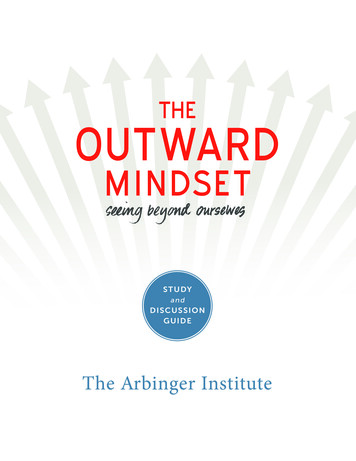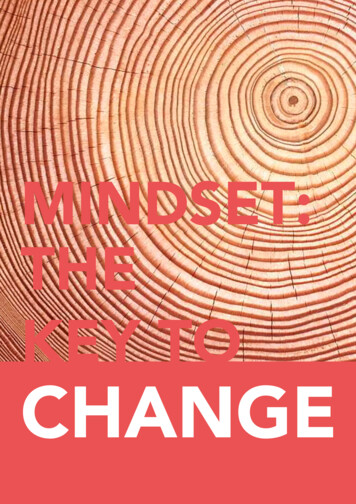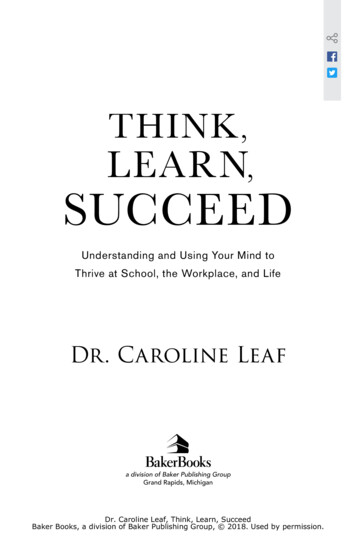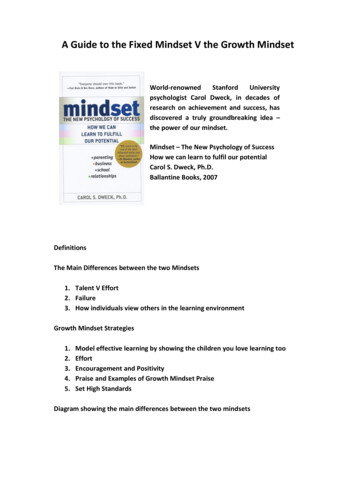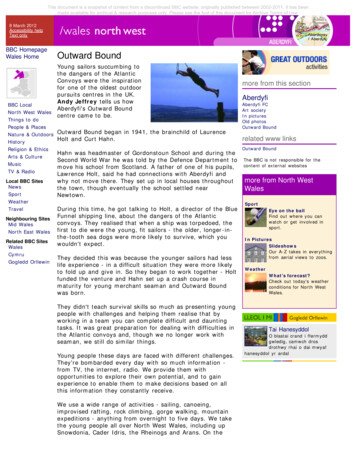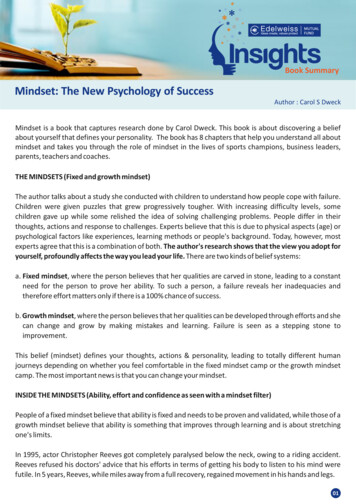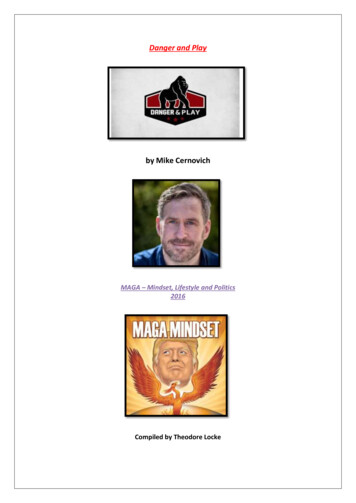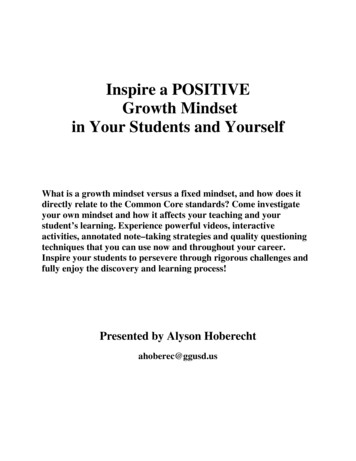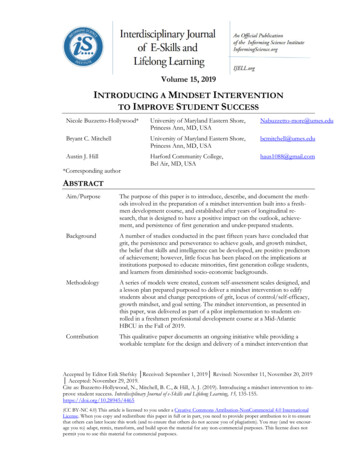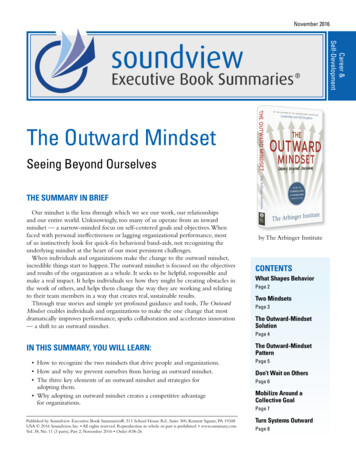
Transcription
November 2016Career &Self-DevelopmentThe Outward MindsetSeeing Beyond OurselvesTHE SUMMARY IN BRIEFOur mindset is the lens through which we see our work, our relationshipsand our entire world. Unknowingly, too many of us operate from an inwardmindset — a narrow-minded focus on self-centered goals and objectives. Whenfaced with personal ineffectiveness or lagging organizational performance, mostof us instinctively look for quick-fix behavioral band-aids, not recognizing theunderlying mindset at the heart of our most persistent challenges.When individuals and organizations make the change to the outward mindset,incredible things start to happen. The outward mindset is focused on the objectivesand results of the organization as a whole. It seeks to be helpful, responsible andmake a real impact. It helps individuals see how they might be creating obstacles inthe work of others, and helps them change the way they are working and relatingto their team members in a way that creates real, sustainable results.Through true stories and simple yet profound guidance and tools, The OutwardMindset enables individuals and organizations to make the one change that mostdramatically improves performance, sparks collaboration and accelerates innovation— a shift to an outward mindset.by The Arbinger InstituteCONTENTSWhat Shapes BehaviorPage 2Two MindsetsPage 3The Outward-MindsetSolutionPage 4IN THIS SUMMARY, YOU WILL LEARN: How to recognize the two mindsets that drive people and organizations. How and why we prevent ourselves from having an outward mindset. The three key elements of an outward mindset and strategies foradopting them. Why adopting an outward mindset creates a competitive advantagefor organizations.Published by Soundview Executive Book Summaries , 511 School House Rd., Suite 300, Kennett Square, PA 19348USA 2016 Soundview, Inc. All rights reserved. Reproduction in whole or part is prohibited. www.summary.comVol. 38, No. 11 (3 parts), Part 2, November 2016 Order #38-26The Outward-MindsetPatternPage 5Don’t Wait on OthersPage 6Mobilize Around aCollective GoalPage 7Turn Systems OutwardPage 8
THE COMPLETE SUMMARY: THE OUTWARD MINDSETby The Arbinger InstituteThe author: The Arbinger Institute delivers training, consulting, coaching and digital tools to help individuals and organizations change mindset, transform culture, accelerate collaboration and innovation, resolve conflict and sustainablyimprove results. As a result of its 35-year track record with clients, Arbinger is now recognized as a world leader in theareas of mindset change, leadership, team building, conflict resolution, crisis management and culture change.The Outward Mindset: Seeing Beyond Ourselves; How to Change Lives and Transform Organizations by The ArbingerInstitute. Copyright 2016 by Arbinger Properties, LLC. Summarized by permission of the publisher, Berrett-Koehler. 192pages, 16.95, ISBN 978-1-6265-6715-3. To purchase this book go to Amazon.com.Summary copyright 2016 by Soundview Executive Book Summaries www.summary.com, 1-800-SUMMARY.IntroductionThink of the following people: the three people in yourlife whom you most like; the two people who’ve had themost positive influence on you; your best boss; the personwho inspires you to do your best; your three favoriteco-workers; the acquaintance you most respect.As you think about these people, consider why youlike them, respond well to them, work hard for themand revere them. Many of the people you are thinkingabout likely have this in common:You feel seen by them.Something about the way they see and engage with youmakes you feel as if you matter.You feel this way whenyou are with them because to them, you do matter. Thischaracteristic you admire in others is a way of seeing thatis called an outward mindset.People often use the term “mindset” to refer to acore belief about oneself. However, the biggest lever forchange is not a change in self-belief but a fundamentalchange in the way one sees and regards one’s connectionswith and obligations to others. Understanding thedifference between a self-focused inward mindset and anothers-inclusive outward mindset will help you becomemore outward in your work, your leadership and yourlife. It will guide you in building more innovative andcollaborative teams and organizations. And it will helpyou see why you like many of the people you do andwhat you can do to become more like them.Developing an outward mindset is a matter of learningto see beyond ourselves. “Leaders fail,” says Paul Hubbard,CEO of a healthcare company, “by coming in saying,‘Here’s the vision. Now you go execute what I see.’Although leaders should provide a mission or context andpoint toward what is possible, what humble, good leadersalso do is to help people see. When people see, they areable to exercise all their human agency and initiative.When they do that, they own their work. When peopleare free to execute what they see, rather than simply toenact the instructions of the leader, they can change coursein the moment to respond to ever-changing, situation-specific needs. That kind of nimbleness and responsiveness issomething you can’t manage, force or orchestrate.”Our journey begins with a foundational idea: Mindsetdrives and shapes all that we do — how we engage withothers and how we behave in every moment and situation. lPART I: SOMETHING NEWWhat Shapes BehaviorCountless books on personal improvement andorganizational transformation recount the behaviors andactions of people who have achieved remarkable resultswith the promise that, by replicating their behaviors, youcan achieve similar outcomes. This formulaic approachto improvement takes as its starting point the simple ideathat behaviors drive results.The idea that behaviors drive results seems almostself-evident. But how many of us have tried to replicate abehavioral formula — adopting the same leadership practices or mimicking the same interpersonal approaches ofthose who have achieved enviable results — only to throwup our hands in frustration? “Well, that didn’t work!”1-800-SUMMARYPublished by Soundview Executive Book Summaries (ISSN 0747-2196), 511 School House Road.,Suite300, Kennett Square, PA 19348 USA. Published monthly. Subscriptions starting at 99 per year. Copyright 2016by Soundview, Inc. Available formats: Summaries are available in several digital formats. To subscribe, call us at1-800-SUMMARY (240-912-7513 outside the United States), or order online at www.summary.com. Multiple-subscription discounts and corporate sitelicenses are also available.service@summary.comRebecca S. Clement, Publisher; Sarah T. Dayton, Editor in Chief; Ashleigh Imus, Senior Editor; Masiel Tejada, Graphic Designer; A. Imus, Contributing Editor2 Soundview Executive Book Summaries www.summary.com
SUMMARY: THE OUTWARD MINDSETThere are two core problems with a purely behavioralapproach for improving performance: The behaviors people choose to engage in (that theysense are right and helpful given their situation) willdepend on how they see their situation and thosewith whom they interact. So while behaviors driveresults, behaviors themselves are informed and shapedby one’s mindset. In whatever a person does, his or her mindset comesthrough, and others respond to this combination ofbehavior and mindset. This means that the effectiveness of an individual’s behaviors will depend to somesignificant degree on that individual’s mindset.Change efforts built upon the incomplete behavioral-model approach, where a person or organization triesto improve performance by focusing only on behaviorchange, will fail much more often in comparison toefforts that focus on changing both behavior and mindset.Studies conducted by McKinsey & Company corroboratethis, showing that organizations that “identify and addresspervasive mindsets at the outset are four times morelikely to succeed in organizational-change efforts than arecompanies that overlook this stage.”When you sufficiently improve the mindset — either ofan individual or of an organization — you no longer haveto specify everything each team member is supposed todo (the way those who operate from a behavioral modeloften assume). As the mindset changes, so does the behavior, without having to prescribe the change. And wherecertain behaviors still need to be stipulated, the suggestionswon’t be systematically resisted. For these reasons, mindsetchange facilitates sustainable behavior change.Moreover, as the mindset changes, people beginthinking and acting in ways that hadn’t been imaginedbefore. Let’s begin to explore the mindset that makesthis possible. lTwo MindsetsIncentive structures, company metrics, career goalsand personal egos all conspire to keep people focused onthemselves and their own perceived needs and challenges,usually to the detriment of the team and the enterprise. Inshort, organizations and their people get inwardly focused,and as a result, they get stuck. They consider only thoseoptions that would advance their own agendas. This wayof operating is called an inward mindset.With an outward mindset, people are able to considerand behave in ways that further the collective results thatthey are committed to achieve. These two mindsets — aninward mindset on the one hand and an outward mindseton the other –– form two ends of a continuum. Consider,for example, an organization in which every personoperates with an inward mindset and where the practices,policies and processes continually invite the same. Noorganization is completely this way, but consider thisextreme case as the left end of the mindset continuum.Then consider an organization composed of people,processes, and practices that are entirely outward. Again,no single organization operates with a completely outwardmindset, but consider that possibility as the extreme rightend of the continuum.The objective is to move individuals and organizationsfurther to the right on the mindset continuum. Why?Because accountability, collaboration, innovation,leadership, culture and value to customers all improve asorganizations increasingly apply an outward mindset intheir strategies, structures, systems, processes and day-today work.Seeing TruthfullyWith an outward mindset, you are alive to and interestedin others’ needs, objectives and challenges; you see othersas people. With an inward mindset, on the other hand, youbecome self-focused and see others not as people withtheir own needs, objectives and challenges but as objectsto help you with yours. Those that can help you, you seeas vehicles. Those that make things more difficult for you,you see as obstacles. Those whose help wouldn’t matterbecome irrelevant.Don’t confuse introspection with an inward mindset.One can introspect in a self-centered way, which wouldindicate an inward mindset. However, a person also canintrospect about one’s connections with others, which is thevery essence of outwardness. Sometimes it is helpful to lookinside to see how one is connected with what is outside.Seeing people as people rather than as objects enablesbetter thinking because such thinking is done in responseto the truth: Others really are people and not objects.This truth, once seen, enables change even where changeseems most unlikely. Rok Zorko, vice president of productdevelopment for the very successful app-developmentcompany, Outfit7, said, “It is an eye-opener to realize thatyou are not to treat people as objects but to treat themas people. Once you have this knowledge, you can neverunthink it.” lwww.summary.com Soundview Executive Book Summaries 3
SUMMARY: THE OUTWARD MINDSETPART II: EXPLORING THEOUTWARD MINDSETGetting Out of Our Own WayFor all the advantages that an outward mindset seemsto offer, why would people ever be inward? It is temptingto blame difficult circumstances or challenging people.However, what keeps people from an outward mindset isthemselves. We get in our own way.You might find yourself in circumstances that make thisclaim sound naive.Your boss may be difficult to work for.You might be on the brink of financial ruin or feel as ifyour career has hit a dead end. In response to these orother difficulties, perhaps you have felt compelled towardan inward mindset.Let’s consider how this happens. Let’s say that you workwith someone named Lori. Suppose that one day youcome across a piece of information that will be very helpful to you in your work. Suppose as well that from yourunderstanding of Lori’s needs and objectives, you realizethat the information would be very helpful to Lori. If youhave an outward mindset, knowing that the organization’ssuccess depends on your colleague’s success as well as yourown, you will feel an obligation to help your colleaguesucceed. Recognizing that Lori would be helped by theinformation, you will have the desire to share it with her.But what if you were to choose not to share theinformation? What if Lori once did something that madea situation harder for you? As you begin to entertain thepossibility of not sharing the information with her, do youthink that you might remember that time when she didn’thelp you? What if she has some annoying habits? Maybeyou don’t know Lori very well. Not knowing her wouldgive you a lot of room to imagine what she must reallybe like. What picture of Lori would make it easier for youto feel justified for not sharing the information? Lori ashardworking or lazy? Trustworthy or unreliable? Helpfulor uncooperative?With an inward mindset, you see Lori in distortedways — ways that help you feel justified for decidingnot to help her.You will zero in on anything in her or inthe situation that will give you this apparent justification.“She doesn’t help me,” you might say to yourself. “Andshe’s really an annoying person.You can’t trust her either;no one who is really trustworthy has such shifty eyes.Besides, if she worked harder, she would’ve discovered theinformation herself. I shouldn’t reward slothfulness. No,that wouldn’t be good for the company. It would really bea mistake if I shared this with her.”Your self-talk and howyou are now feeling toward Lori will justify the way youare choosing to live.Are there people in your life, either at work or at home,whose needs, objectives and burdens you resist seeing?How about people that you don’t resist — people withwhom you are open, curious, interested, aware? As youcompare these relationships, what differences do younotice in how you feel and act? Can you spot any blamein what you tell yourself about others or any self-justifyingnarratives that you’ve come to believe about yourself?The most troubling areas of our lives will be those inwhich we resist what the humanity of others invites us tosee. This is a hopeful truth. It means that we can be rid ofthe distorted ways of seeing that strain our connectionswith others. We can stop resisting.The Lure of InwardnessWithin organizations, every person who is burningtime and energy seeking justification is doing so at theexpense of the contribution he or she could be making tothe overall results of the company. The energy-draining,time-wasting, silo-creating effect of this justificationseeking is one of the most debilitating of organizationalproblems. Entire organizations can fall prey to the lure ofinwardness with spectacularly damaging results.An inward-mindset style can easily be mistaken for anoutward mindset. This style omits the needs, objectives andchallenges of others. Even though people or organizationsoperating with this style of inwardness feel as if they aredoing things for others and not for themselves, they aren’tpaying attention to the needs, objectives and challengesof those they are supposedly doing things for. They don’texperience themselves as being egocentric. They feel as ifthey do good things for others all the time and actuallyexperience themselves as being outwardly facing.What is the cost of an inward mindset? When peoplefocus on themselves rather than on their impact, lots ofactivity and effort get wasted on the wrong things. Theabsence of collaboration results in low levels of innovation.And employees disengage due to the boredom inherentwith inward-mindset thinking and working. lThe Outward-Mindset SolutionA person conceiving her work with an outwardmindset is alive to and interested in the needs, objectivesand challenges of each of the persons toward whomshe has responsibility — toward her customers, direct4 Soundview Executive Book Summaries www.summary.com
SUMMARY: THE OUTWARD MINDSETreports, peers and manager. Her objectives and behaviorstake these people’s needs, objectives and challenges intoaccount. Her focus is outward on something much largerthan herself — on her essential contribution to the overallgoals of the organization. And thinking of her role in thisway requires her to focus on doing her work in a way thathelps others to do theirs.The power of this outward-mindset approach can beseen in the results of an innovative debt-collection agencythat has built its entire mission and strategy in terms of theoutward mindset. The company is CFS2, headquartered inTulsa, Oklahoma.Bill Bartmann, founder and CEO of CFS2, has knownhis own hard times. Having been hounded by debt collectors himself, he wanted to build a debt-collection companythat worked differently — which is to say, outwardly.Bill and his company focus on treating those who arein debt with dignity and respect. They operate from thepremise that their clients owe them money preciselybecause they don’t have enough money to pay them. Thetypical approach to debt collection — an inward-mindsetapproach — is to browbeat those who owe money untilyou squeeze whatever you can out of them. An outward-mindset approach, on the other hand, begins withthinking about these people and what they are up against.Those who take this approach are alive to and interestedin the challenges these people are facing, and their missionis to help them with those challenges.With this approach, Bill Bartmann and his peoplebegan by figuring out how they could help their clientsmake money. Bill asked his entire workforce to beginbrainstorming and experimenting to see how they couldbest help their clients get jobs. At first, they tried givingtheir clients advice and suggestions about what to do. Butthis didn’t seem to help much. One of Bill’s employeesoffered this observation: “They can’t do the heavy liftingthemselves — they’re so beat down they have no get-upand-go left.”So the employees of CFS2 began writing résumés fortheir clients. They began looking for job opportunities forthem, helping them fill out applications and schedulingjob interviews. They ran mock interviews to prepare themfor the real thing. And they even began calling their clientson the mornings of their appointments to get them out ofbed early enough to arrive at the job interview on time!From there they began helping in other ways. Anyheadache in their clients’ lives became an opportunity tohelp. CFS2 has identified a myriad of organizations thatexist to help people in need with these and many otherservices, and Bill’s team brings in these organizations tohelp meet the needs of their clients. And they do all thisfor free. In fact, Bill rewards his employees not for howmuch debt they collect but for how many free servicesthey can provide to their clients!From an inward-mindset perspective, this all seems crazy.But the results speak for themselves. After just three yearsin the industry, CFS2’s rate of collection was two timesthat of any firm in the industry.We see in the CFS2 story how an outward-mindsetapproach can mobilize an entire company to work onbehalf of its customers — not just to provide a productor service but to enthusiastically innovate to meet thecustomers’ needs and help them achieve their own objectives. Inward-mindset people and organizations do things.Outward-mindset people and organizations help others tobe able to do things.Now let’s explore a proven methodology to move froman inward mindset to an outward mindset. lPART III: BECOMING MORE OUTWARDThe Outward-Mindset PatternThose who work with an outward mindset see theneeds, objectives and challenges of others; adjust theirefforts to be more helpful to others; and measure and holdthemselves accountable for the impact of their work onothers. Engaging in these three steps is a practical approachto implementing and sustaining an outward-mindset wayof working.You can remember the pattern with the simpleacronym SAM — see others, adjust efforts, measure impact.Alan Mulally was hired as president and CEO at Fordin September 2006. Bleeding at the rate of 17 billion peryear, Ford put all its remaining chips on Alan Mulally. AsMulally soon discovered, no one at Ford felt responsiblefor the problems of the company.Mulally led through a mechanism of weekly meetings,including the Business Plan Review, or BPR. Mulallytrained his executive team to come to the BPR preparedwith charts that showed performance against the companyplan for each area of responsibility. He had them color-code their charts: Anything that was on plan was to becoded green, anything at risk of going off plan was to becoded yellow, and anything off plan was to be coded red.Mulally also pointed to 10 BPR rules: people first;everyone is included; compelling vision; clear performancegoals; one plan; facts and data; propose a plan, “find-a-way”www.summary.com Soundview Executive Book Summaries 5
SUMMARY: THE OUTWARD MINDSETattitude; respect, listen, help and appreciate each other;emotional resilience trust the process; have fun enjoy the journey and each other.As the executives presented, each and every chart wascoded green. Why? Because you couldn’t be wrong atFord and keep your position. “The company was underperforming, sure,” the executives would privately admit,“but I’m not.”The next week, just before the new Ford Edge wasabout to ship out of Oakville, Ontario, Canada, a testdriver reported a problem on one of the test vehicles: Thetailgate had an actuator problem. Mark Fields, who ledFord’s operations in the Americas, had a decision to make.Telling the truth, exposing challenges in your area ofoperations, usually resulted in losing your job. Fields feltlike a dead man. If he shipped and the vehicles were faulty,he was a goner. But he was sure that the same fate awaitedhim if he came to the meeting and, in a final blaze ofglory, told everyone that the Edge had a problem.He thought it over and finally decided that since hewas dead anyway, he was going to call it like it was. Heprepared his chart. In red. Everyone around the table knewwhat Mark Fields knew. He was as good as gone.Everyone except one, and that person started clapping.“Mark,” Mulally smiled as he clapped, “that is great visibility.” Then he turned to the rest of the group and askedthe question that was the beginning of their education inthe outward mindset: “Who can help Mark with that?”At that invitation, a number of Fields’ colleagues jumpedin with offers. One said that he had seen that issue onanother vehicle and would get that information to Fieldsimmediately. Another offered to quickly get a group of histop-flight engineers to Oakville to help on any redesignthat might need to happen. And so on.When he showed up the following week with his Edgechart still red, but moving to yellow, and Mulally still smiling at him, the others began to realize that Mulally was forreal. “You aren’t red,” Mulally insisted. “The issue you’reworking on is red.” And he wanted them to help eachother with the challenges they each faced, something theycould do only if they came forward with their challenges.The week after that, the charts around the room had somuch red that the meeting looked like a crime scene.You may know the rest of the story. Working this waytogether and spreading this helpful, self-accountableapproach throughout the company, Ford was able to pullitself out of a deep ditch — to such a degree that it wasable to get in front of the financial crisis of 2007–08 as theonly American automobile manufacturer that didn’t haveto take federal moneys to survive. Alan Mulally retiredfrom Ford in the spring of 2014. His replacement at Fordwas Mark Fields.The Three ElementsThink about the Ford turnaround story in relationto the three elements of the outward-mindset pattern.Regarding the first step — seeing the needs, objectives andchallenges of others (and the organization as a whole) —the BPR process itself gave the members of Mulally’s teamvisibility both into their own contribution to the wholeand into the needs, objectives, challenges and activities oftheir colleagues. Because Mulally’s mindset was outwardin the way he worked with his team and conducted thesemeetings, that forum offered the Ford team an opportunity to see their own roles in relation to others.The second step of the outward-mindset pattern isadjusting one’s work to become more helpful to others.This step naturally follows the first. Once the team couldsee the challenges faced around the table, Mulally invitedthem to step up and help. “Who can help Mark withthat?” was more than a question. It was a statement abouthow Mulally wanted his people to take responsibility notjust for their own part in the overall project but also fortheir impact on their colleagues’ ability to successfullyfulfill their responsibilities.Lastly, they gathered together each week to see if thehelp they were providing was making any difference intheir co-workers’ ability to get results. This is the third stepin the outward-mindset pattern: measuring impact. Mulally’s process gave the Ford team at least a once-a-week wayof assessing whether the adjustments being made by thosearound the room were actually helping. Each week theyhad the opportunity to assess their impact on one anotherand the company’s overall results and make necessaryadjustments. The turnaround at Ford depended on theteam’s engaging in each step of the outward-mindsetpattern: See others, adjust efforts and measure impact. lDon’t Wait on OthersWhile the goal in shifting mindsets is to get everyoneturned toward each other, accomplishing this goal ispossible only if people are prepared to turn their mindsetstoward others with no expectation that others will changetheir mindsets in return. This capability overcomes thebiggest impediment to mindset change: the natural,inward-mindset inclination to wait for others to changebefore doing anything different oneself. This is the natural6 Soundview Executive Book Summaries www.summary.com
SUMMARY: THE OUTWARD MINDSETtrap in organizations. Executives want employees tochange, and employees wait on their leaders. Everyonewaits. So nothing happens.Ironically, the most important move in mindset work isto make the move one is waiting for the other to make.Sometimes people are afraid to make this move becausethey think that others may take advantage of them if theydo. But people misunderstand if they think that workingwith an outward mindset when others refuse to dothe same makes a person blind to reality or soft on badbehavior. It does neither.In fact, what obscures vision and exposes people tomore risk is not an outward mindset, which stays fullyalive to and aware of others, but an inward one, whichturns its attention away from others while simultaneouslyprovoking resistance. People who work in dangerous,high-risk situations know this most of all — people likethe Navy SEALs and SWAT team members. They knowthat their lives and missions depend on their ability toremain fully aware of the complexities of their situationsand to do so in a way that doesn’t stir up escalatedresistance. The outward mindset doesn’t make them soft; itmakes them smart.Remember, the principle to apply is, “As far as I amconcerned, the problem is me. I am the place to start.Others’ responses will depend mostly on what they see inme. The most important move is for me to make the mostimportant move.” lPART IV: MULTIPLYING THEMINDSET CHANGEMobilize Around a Collective GoalIn organizations that have successfully built outward-mindset cultures, one factor is constant: The leadersinvolved their organizations in pursuing a collectiveresult — that is, a result that at once involved everyonein something much bigger than himself or herself andrequired that everyone join together with others in orderfor their efforts to succeed.Every organization already exists as a collective, butvery often, people in organizations mostly identify aroundtheir separate, individual roles. They don’t have an understanding of how their own roles are essential to the overallcollective result of the organization.Here are some questions you can ask yourself as youutilize the outward-mindset-at-work framework forredefining your role in this way: Toward your manager. Do I have a clear understanding of my manager’s objectives? What can I doto learn about them? What do I need to do to makesure that I am holding myself accountable for mycontribution to my manager’s results? Toward your customers. Who are my customers,and what objectives do they have that I could helpthem with? How will I measure whether they are, infact, helped by my efforts? Toward your peers. Which of my peers areaffected by my work? Do I know whether I amhelping or hindering them in their ability toaccomplish their objectives? Toward your direct reports. Are my direct reportsgrowing in their abilities? Have I worked with themto set a collective result for the entire team, and dothey understand how they contribute to that result?Are they holding themselves accountable for thatimpact in each of the directions of their work? Whatcan I do to help them to do this?Wherever you are located in your organization, youcan begin to rethink your work so that you see yourselfin the context of achieving your own essential part of acollective result. lAllow People to Be FullyResponsibleWithout realizing it, too many leaders assume that therole of leadership is to cont
The Outward-Mindset Solution Page 4 The Outward-Mindset Pattern Page 5 Don’t Wait on Others Page 6 Mobilize Around a Collective Goal Page 7 Turn Systems Outward Page 8 THE SUMMARY IN BRIEF Our mindset is the lens through which we see our work, our relationships and our entire world. Unknowingly, too many of us operate from an inward
